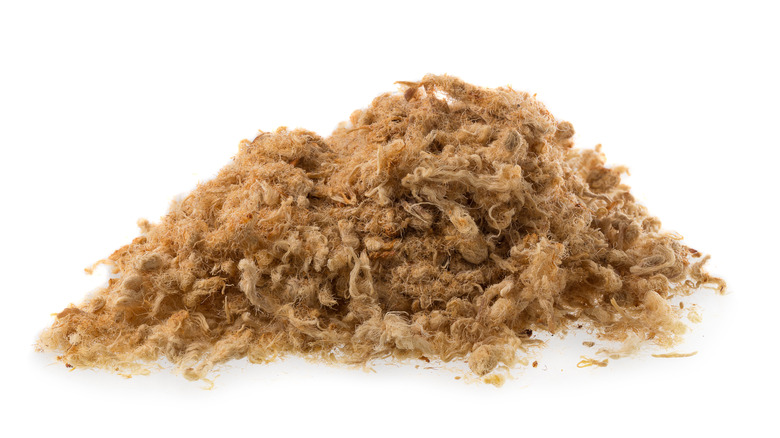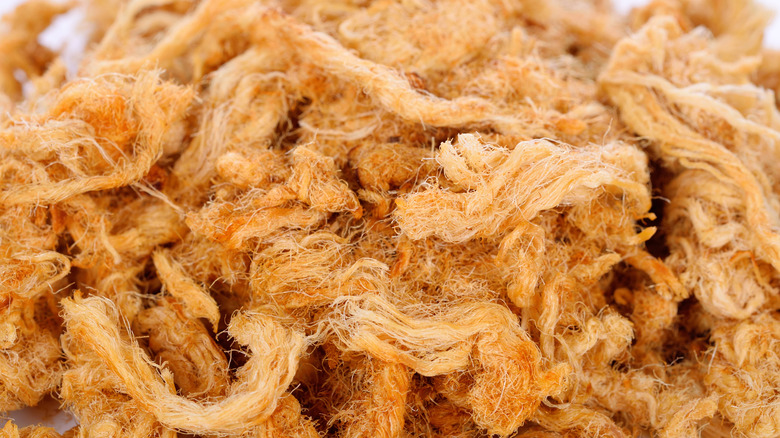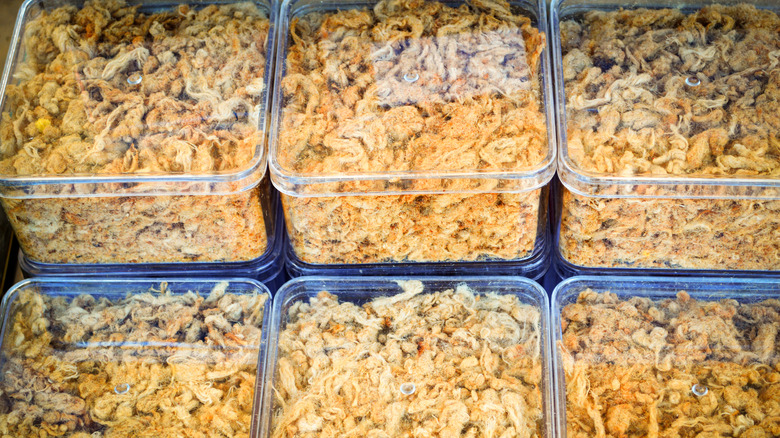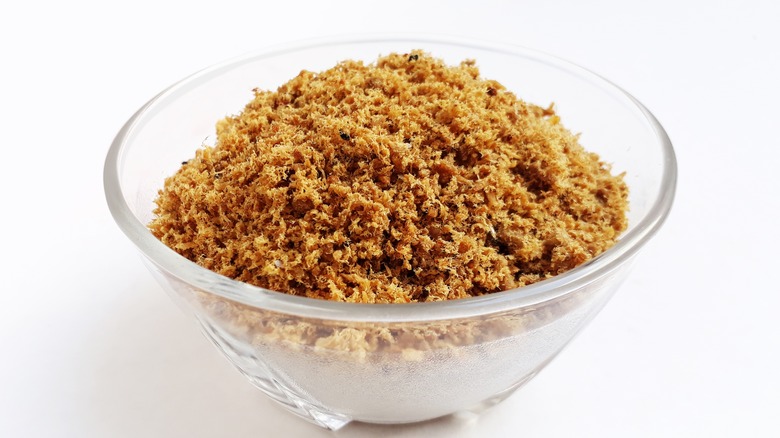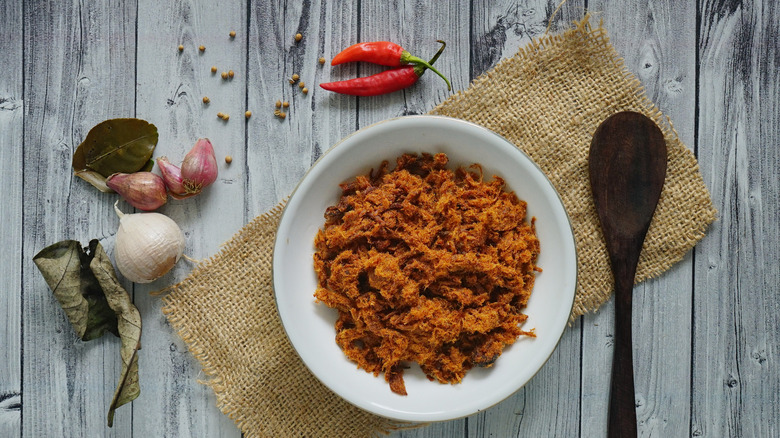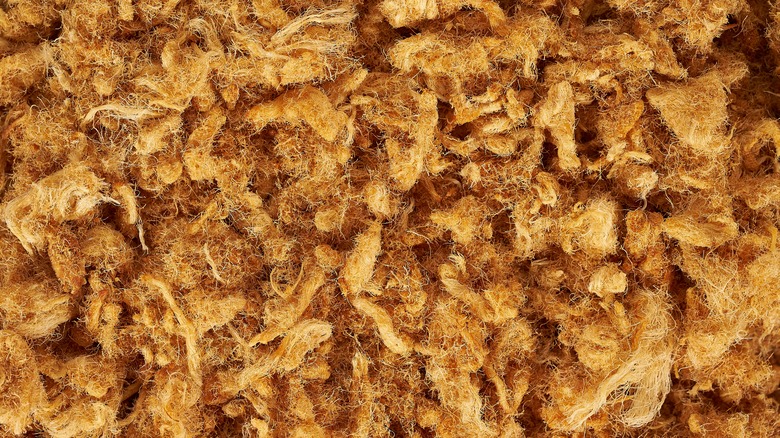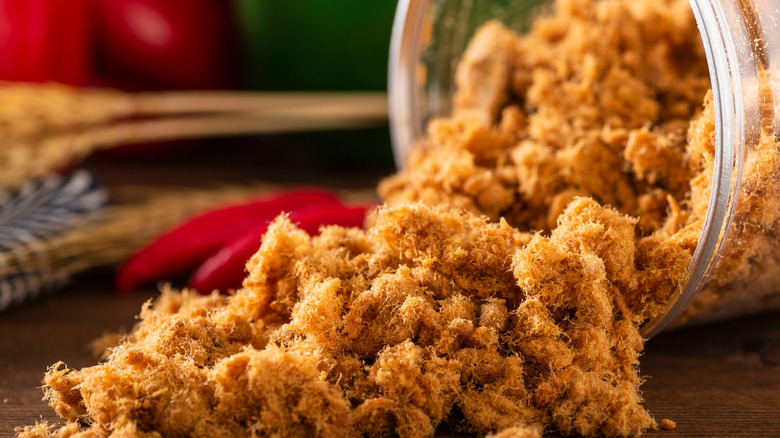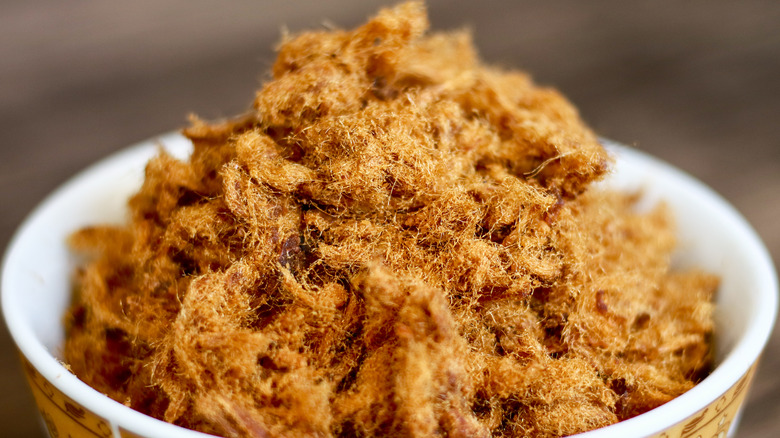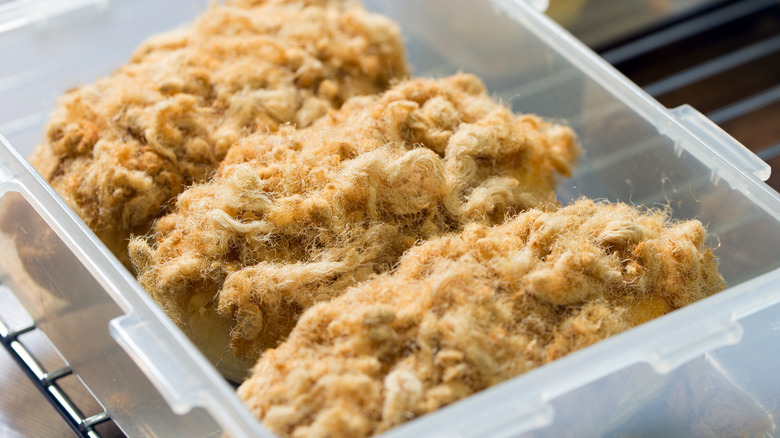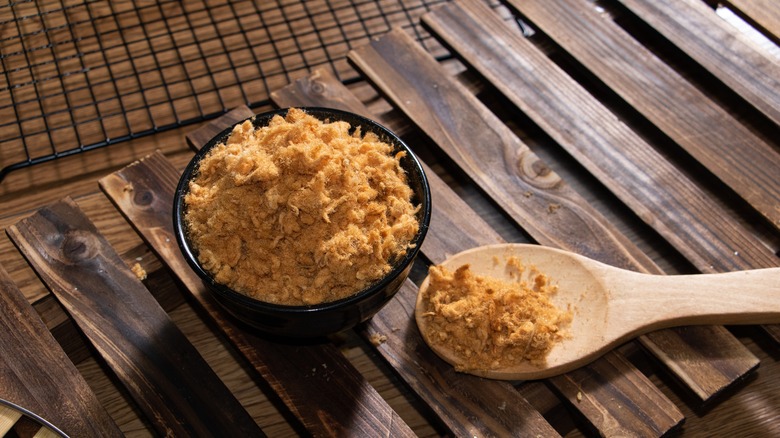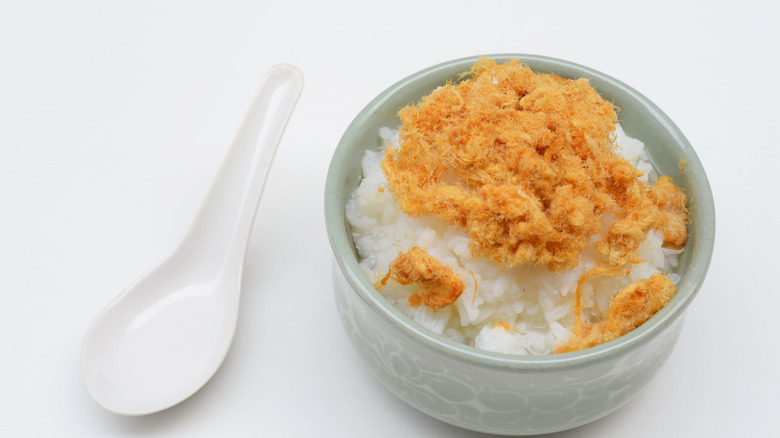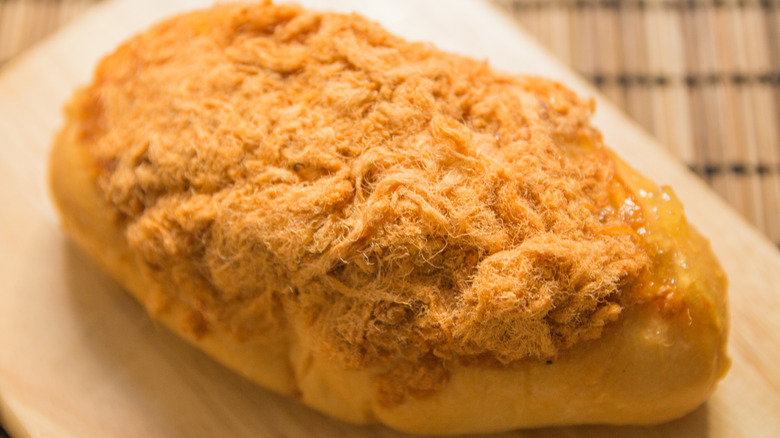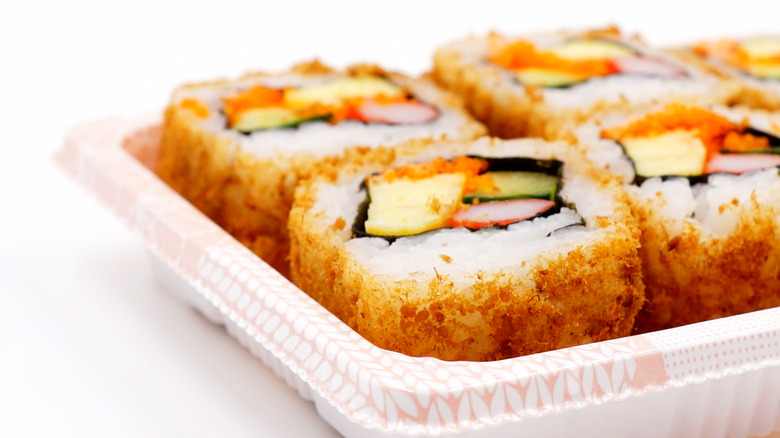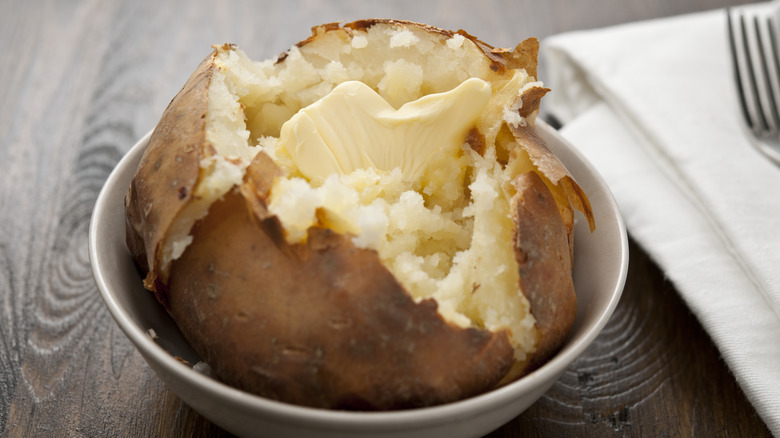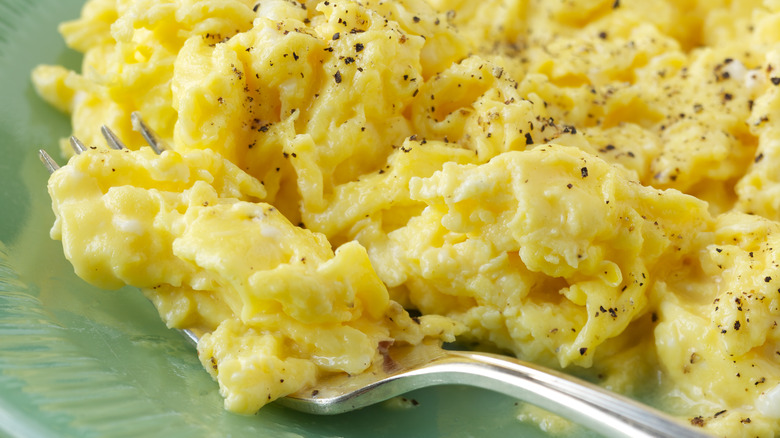Pork Floss: The Meaty Chinese Ingredient That Looks Like Cotton Candy
We may receive a commission on purchases made from links.
We admittedly get a little giddy every time we get to find and learn about a new ingredient that we haven't cooked with before. Not only does learning about these ingredients give us a chance to expand our palate, but it also allows us to find new ways to use these ingredients to upgrade our current favorite recipes. This time around, that ingredient is pork floss.
Pork floss is the dream for anyone who has ever wanted to eat savory cotton candy. Seriously, if your mouth didn't water at that, we would be amazed. Although it's often relegated to the back shelves at our local Asian market, the ingredient has recently surged in popularity thanks to social media channels like TikTok, where one user praised it as a delicious "fluffy jerky." We've researched the scoop on this Asian ingredient and found the best ways to use it in your home kitchen.
What is pork floss?
Pork floss, otherwise known as "ròusōng," is a dried Asian condiment used for dressing up everything sweet and savory. The unique and versatile meat product is made by stewing and shredding pork to resemble a fibrous material with a texture akin to cotton candy, insulation, or tobacco. Once the pork floss reaches the perfect consistency, it is seasoned with ingredients like sugar, monosodium glutamate, soy sauce, and East Asian spices before being cooked and shredded to get the perfect airy consistency. This pork product's unique blend of spices and textures gives it an umami, savory, and slightly sweet profile unlike any other meat you've ever tasted.
Individuals in East Asian countries and folks who discovered the ingredient from popular media like TikTok use pork floss to provide a delightful crunch and bright flavor to their recipes. It is popular as a topping and a filling for traditional Asian foods, including congee, buns, and pastries. Moreover, the ingredient is highly praised for its high protein content, portability, and umami-rich profile.
How is pork floss made?
While most people think about buying pork floss from a merchant off Amazon, some people venture to make the pork product themselves in their home kitchens. Believe it or not, reaching the soft, airy texture of the perfect pork floss without an industrial machine getting involved is possible. The first step in the process is taking a cut of meat, often a tenderloin because of its leanness, and breaking it down into small pieces so that it cooks all the way through. The meat must be cooked meticulously, either by steaming or boiling, to ensure that the length of the pork floss is consistent and so that the meat has the opportunity to soak up all the flavoring agents, like scallions, garlic, ginger, or Shaoxing wine. The cook must also be sure to skim the fat particles off the top of the boiling water, as this will alter the final texture of the meat.
After the meat has cooled down, it is shredded by hand before being added to a hot wok or pan. At this time, the cook will add the soy sauces, sugar, and spices to the mixture and keep cooking it until the juice has dried off. Then, the meat can be dried and pulled apart again until it resembles the perfect texture.
Who invented pork floss?
The answer of who "invented" pork floss is a bit of a mystery. It was believed that the Mongols, nomadic warriors who traveled across the Asian continent nearly 1000 years ago, were the first to use pork floss and dehydrated milk as a source of protein for their journies. Since the meat was dehydrated, it was easier to carry it across the land without weighing down their packs. Genghis Khan, the first Khan of the Mongolian Empire, likely enjoyed a bite or two of this savory sprinkle during his reign.
Modern food processing technology has changed how pork floss is created, allowing the product to be mass-produced and shipped across international borders. This has contributed to its widespread popularity across regions and cuisines, although it does remain a popular facet of the culinary identity of the areas in which it was once utilized, including China, Vietnam, Hong Kong, and Taiwan.
Can you make floss with other meats?
While pork floss is the most ubiquitous type of dried meat floss, other proteins are also used for similar products. Chicken floss, for example, is made with skinless chicken breasts and seasoned in the same way as pork floss. As expected, this poultry product has less of an umami flavor and richness to it than the porcine variety. Beef floss, a popular protein in Malaysia, can also be made by boiling a large cut of low-fat beef and concentrating its savory flavor with a blend of chiles and spices. These different meat alternatives cater to other dietary and food preferences, thus widening the range of dishes and cultures that can eat it.
There has also been movement in recent years to develop more unconventional floss varieties from fish and shrimp, too. Serunding ikan, another Malaysian product, is made by cooking a fish called the threadfin bream with aromatics and spices until it resembles floss consistency. Other culinary innovators have found ways to make entirely plant-based floss from sliced textured vegetable protein, a soy-based product.
What are the primary types of pork floss?
There are two primary types of pork floss available on the market: pork sung and pork fu. The former is what we think of as pork floss — the stringy, shredded, and dehydrated pork product that is sold in large containers. It has a savory umami profile and is a popular ingredient for sprinkling on or filling different foods. In contrast, pork fu is a drier and more solid form of pork sung with a more prominent chew factor. Its fibers tend to be longer than pork sung, giving it a different mouthfeel and allowing it to soak up juices without immediately breaking down like cotton candy.
There are also some minor regional differences in pork sung. For example, the Taiwanese preparation is made with leaner pork, while it is made with a fattier version of the meat in Hong Kong. In addition, other regions will also blend the pork with other types of fish, poultry, or meat to give it a unique flavor.
What does pork floss feel and taste like?
It's difficult to describe what pork floss is to someone who has never eaten it. Its texture has a delicate balance of softness and airiness, which gives it a soft-cotton consistency. Eaters have noted that the food melts on your tongue like cotton candy (candy floss) but is packed with more savory notes. The exact flavor of the pork floss will depend on the ingredients it's made with. For example, pork floss made with fish sauce, soy sauce, and monosodium glutamate (MSG) will have a more umami flavor than one made with dried chilis, which will have more spicy notes that linger on the tip of the tongue.
The color of the meat is also dependent on what types of sauce you add to it. Many folks will make pork floss with dark soy sauce and light soy sauce. The former gives the meat a darker brown color, while the latter amps up the savoriness.
Is pork floss healthy?
The healthiness of an ingredient is relative, especially one that's predominantly used as a condiment rather than a whole meal. Moreover, the nutritional profile of pork floss is dependent on the ingredients that it's made with. For example, soy sauce can increase the flavor of the meat but also drive up the sodium content of the dish. A 100-gram serving, which is more than a little dusting the average person might spread on their fried rice, has about 345 calories and 45 grams of protein. The exact fat content will vary since some preparations of pork floss use fattier cuts of meat than others. In addition, pork floss may also not be a suitable ingredient for folks with allergies to soy or gluten, depending on the seasonings used in the recipe. There is also the potential use of preservatives in this product to extend its shelf life.
Individuals waking to this protein at home can curb the use of sugars or high-sodium seasonings to make the meat healthier. But since it's rarely eaten as a meal, many folks won't bother altering the recipe.
Is pork floss used outside of Asia?
Although pork floss is commonly associated with Asian countries, it can also be found outside of the continent. For example, a Northern Nigerian delicacy, Dambu Nama, is made with beef, ram, or mutton. However, some preparations will also use pork or chicken (dambu kaza). However, since this region of the world is dominated by the Muslim faith, which forbids the consumption of pork, other alternatives to the protein are common. The Nigerian preparation of this meat uses regional spices like cloves, curry powder, ginger, and thyme to season the beef after it has cooked on the stovetop for several hours. In addition, the dish is made with Suya spice, a dry peanut-based beef rub, before it's cooked.
In comparison, Asian preparations of pork floss often stick to seasonings like soy sauce, anise, and scallions. If you make this at home, you can add your own blend of seasonings specific to how you plan on using the ingredient.
Where can you buy pork floss?
Thanks to the wonders of the internet, you can get pork floss shipped to your door in a matter of days. Otherwise, stop by your local Asian market to purchase a container. These stores offer an array of condiments, sauces, and ingredients that can also help you flavor your homemade pork floss. In addition, some specialty grocery stores may carry pork floss, but it may be a hit-or-miss depending on the communities that your supermarket serves.
If you want to sample a pastry made with pork floss, you can check out your local Asian or ethnic bakery to see if they offer the treat. Some snack shops and bakeries in large Asian communities will sell them regularly — and they're always best eaten fresh.
Purchase Kimbo Brand Sung Cooked Dried Pork,18-ounce on Amazon for $21.89
Purchase Kimbo Pork Fu,18-ounce on Amazon for $28.95
Purchase Golden Nest Shredded Dried Pork, 4-ounce on Amazon for $6.79
How do you store pork floss?
Proper storage is critical to ensuring that your homemade or store-bought pork floss stays fresh for as long as possible. With homemade varieties, the key to keeping your pork floss last as long as possible is to cook as much residual moisture off as possible and always allow the meat to cool before snapping on the top of your container. Otherwise, condensation can build inside of the container and cause your protein to spoil or mold faster. Once it's cool, add it to an airtight container to prevent moisture encroachment and stick it in a dry, cool place away from direct sunlight. Vacuum sealing may also extend the shelf life even longer, but this will require equipment that not every home cook has lying around.
Before using your pork floss, look for any obvious signs of mold and discoloration. You should also use clean, dry utensils to extract the pork floss from the jar to prevent any moisture or bacteria from getting into it and ruining your condiment.
Pork floss is a staple for congee
One of the most common uses for pork floss is on an Asian dish called congee. Congee is a thick rice porridge often enjoyed for breakfast or when folks overcome a cold or illness, especially in countries like China, Korea, and Taiwan. The base is simply water and rice that has been simmered for a very long time to resemble a thick custard. Besides pork floss, many cultures top their congee with kimchi, soft-boiled eggs, and meat.
We recommend adding a sprinkle of the pork floss to your morning bowl because it will impart a delectable savory flavor to your rice without requiring you to add extra condiments like soy sauce to the top. In addition, the pork floss plays well with other condiments — especially century eggs. Century eggs, or pidan, are preserved for months and have a very funky, astringent flavor that pairs well with the saltiness of the floss.
Pork floss-stuffed buns are a common bakery item in China
Another common application of pork floss is for buns. This Asian-style recipe is made with an enriched brioche dough that has been rolled into a shape similar to that of a hamburger bun. After the bun has baked, it's topped with a medley of toppings, including pork floss, Kewpie mayo, condensed milk, and sesame seeds. The meaty floss gives the bun a savory flavor, while the other ingredients play on the sweetness of the pork product. If you're making these buns at home, it's important to always dress them with the toppings right before serving since the meat can disintegrate if it gets soggy.
There are many other variations on pork buns, including recipes where the buns have been twisted into braided shapes or even rolled into cinnamon bun-like pastries with mayonnaise and seaweed before being baked until perfectly puffy and golden in color.
It's the sushi condiment you've been missing
Pork floss sushi is a popular dish in Taiwan for its savory flavors and beautiful visual appeal. The rolls are often stuffed with cucumber and seaweed sheets and finished with a dotting of sesame seeds, but there are a ton of variations on how you can make these sushi rolls at home. For example, you can add the pork sung into the middle of each of the rolls or roll it on the outside rice layer for a pop of color.
Other variations of pork floss sushi include protein-dense fillings like ham and eggs in addition to the pork floss. The savoriness of the pork floss is an ideal companion for sushi because it elevates the umami and savoriness of the dish. Plus, you won't have to worry about dipping each roll in soy sauce since it's a staple ingredient in the pork anyway. It's less messy — with a porkier flavor.
Pork floss will help you dress up your baked potatoes
If you aren't a fan of Asian recipes, that doesn't mean you can't jump on the pork floss train. In fact, there are many dishes outside of the Asian continent where pork floss can be used as a flavorful upgrade. For example, your baked potatoes are begging for pork floss. You can use it as a replacement for bacon atop your baked potatoes, which means not having to pre-cook your bacon and, thus, having to do fewer dishes. The pork floss gives your potatoes the same porcine flavor but with an Asian flair. We recommend pairing your pork floss with a bit of butter since the umami flavor in the floss can help brighten the fatty notes, scallions, and a dollop of sour cream. Besides a better flavor, you'll also get a healthy dose of protein on your favorite potato side.
It's also a great addition to scrambled eggs
Baked potatoes aren't the only food getting a boost from pork floss. You can elevate your scrambled eggs with a garnish of pork floss after they're done cooking. Unlike other meaty additions to your eggs, pork floss doesn't have to be cooked before you spoon it on, and the flavor of the meat will permeate every inch of the plate more than a boring hunk of sausage or bacon would. Although the texture of the pork floss will change when you introduce the warmth and moisture of the eggs, its complex flavor will take your recipe to a new level.
You can also add pork floss to your breakfast sandwiches or open-faced toast for a hearty breakfast. Slather your bread of choice with Kewpie mayo before layering on your eggs and pork floss. Every bite will be filled with a meaty, salty flavor to help you start your day on the right foot.
